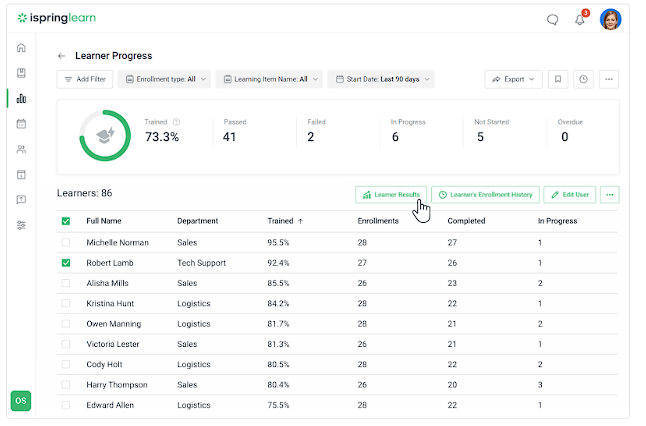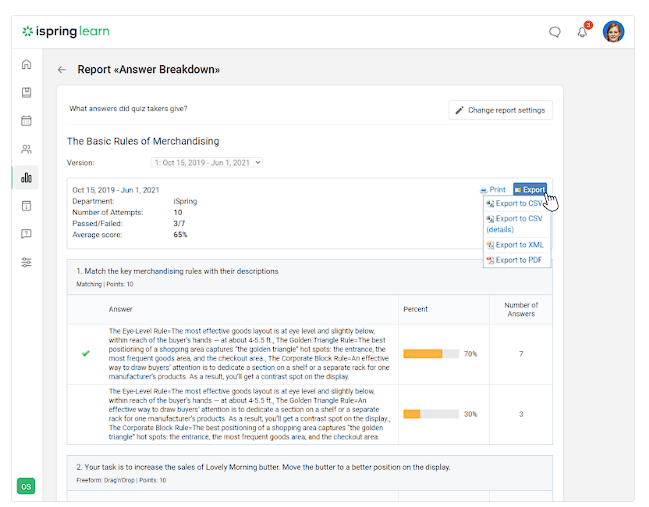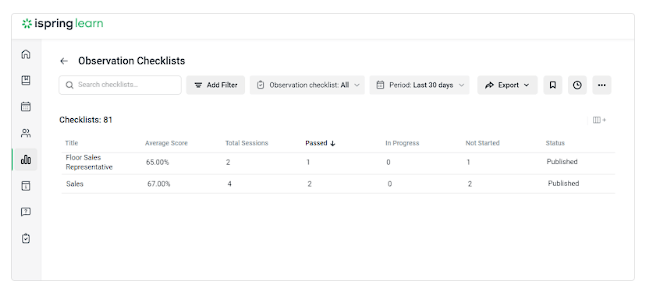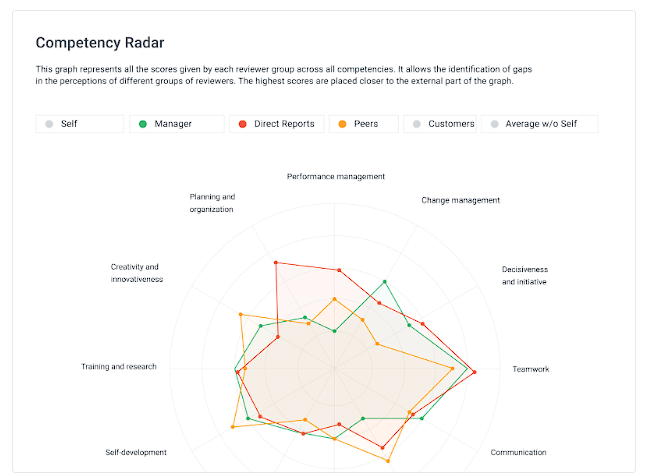Tracking Training Performance with an LMS

Tracking Training Performance: Key Metrics and Reports
To evaluate the effectiveness of training, you need specific metrics that match your goals. Key training metrics should include:
- Finishing level. Percentage of students who complete the course.
- Pass or fail standard. This applies to your evaluation and successful completion.
- Points. It helps you measure student performance and identify skill gaps.
- Student satisfaction. Feedback from students about course content and format.
- It’s time to know. The time it takes for students to reach their desired level of skill.
- Post-training performance. This shows how employee performance has improved (eg, increased sales, improved customer response).
- Return On Investment (ROI). The financial benefit gained from the training compared to its cost.
eBook release
The In-Depth Guide to Making an LMS Really Work for Your Business
Whether you’re new to LMSs or want to get more out of your current environment, this guide will help you make the most of your investment.
Pro-tip: Start by identifying metrics that serve as key indicators of training success in your company. For example, track the completion rate to ensure that more employees complete their courses, aligning with the business goal of holistic employee development. Or, monitor performance improvements by tracking increased sales, which are directly related to revenue growth goals.
Once you’ve established the right training metrics, move on to measuring training performance. You can do this using different methods and models. One of the most widely used models for evaluating employee training is The Kirkpatrick model. It allows you to evaluate the training program and its value to the business at all four levels:
![]()
Reaction
Measure immediate student satisfaction and engagement with the training program. Assessment is based on trainees’ feedback.
How to Scale with an LMS
An LMS is the perfect tool for conducting surveys and gathering employee feedback. You can create and track questionnaires directly in the program, eliminating the need to deal with printed paper forms.
![]()
Examples of employee satisfaction survey questions:
- How satisfied are you with the training content provided?
- Was the training material easy to understand and follow?
- Do you feel more confident about your work after completing the training?
- How likely are you to recommend this training to your colleagues?
- What improvements would you suggest for future training sessions?
Based on the results of the survey, you can:
- Identify areas for improvement.
- Adjust training content and methods.
- Ensure that future training sessions better meet the needs and expectations of your employees.
Reading
Assess the increase in knowledge or skills through tests and assessments conducted during or immediately after training.
How to Scale with an LMS
Use LMS test progress and results reports. Platforms like iSpring Learn offer many reports to monitor employee achievements, including:
Progress and Completion Standards
See how students are progressing in their studies and how many have successfully completed them.

Assessment Points
Scores indicate how well students understand and retain the training material. They show the effectiveness of the training program.
![]()
Assessment Efforts and Classification of Responses
See the number of times instructors take the test and their performance on each question. You’ll get insights into areas where students may be struggling and you may be able to identify specific topics that may need further clarification or repeated training.

Behavior
Evaluate the extent to which the trainees apply the knowledge and skills they have acquired during the training to their jobs. You will see how the training has affected their performance and behavior at work.
How to Scale with an LMS
Use the following LMS capabilities to ensure employees are effectively using their training on the job:
On-the-job Training Checklist
In iSpring Learn, you can use on-the-job training modules as part of your training programs. The LMS provides Checklist reports, with which you can track the results of employee training sessions. This is a solid way to ensure that practical skills are being used correctly in real-world situations and to identify any areas that need further development.

Performance Review
You can also collect feedback in a 360-degree survey format with iSpring Learn. Collect anonymous data on all aspects of employee performance from their customers and colleagues, from subordinates to managers. This way, you can see the employee’s strengths, areas for improvement, and the suitability of their current roles.

In addition, you can use:
- Self-assessment questionnaire
- Customer surveys, comments, or complaints
- Data from work processes (call resolution time, error rates, etc.)
Results
Finally, evaluate the impact training has on your business performance. Again, this relates to the goals you had in mind when you started training with the LMS.
Business outcomes typically include:
- Increased sales. Measure the increase in sales revenue after your students complete the sales training programs.
- Improved customer satisfaction. Track customer feedback scores to see if they improve after training.
- High productivity levels. Check for increased output or efficiency.
- Error rates are reduced. Monitor the reduction of defects or errors in production.
- Employee retention. Assess the impact of training on employee satisfaction and retention rates by comparing profitability before and after training programs.
- Low training costs. Estimate training cost reductions by comparing traditional training methods and the cost of using an LMS.
Tracking these results is necessary to demonstrate the value of your training programs, make data-driven decisions about future training initiatives, and calculate the ROI of the LMS.
Download the Deep-Dive Guide to Making an LMS Really Work for Your Business today to walk you through the entire process of implementing and implementing a Learning Management System.

iSpring Read
iSpring Learn is the fastest LMS for your most important project. Launch your eLearning in one day with minimal fuss. Simply upload your training materials, invite employees, and track their results.
Source link



